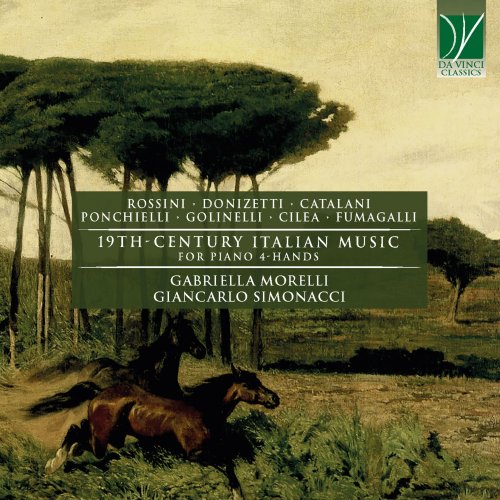Tracklist:
01. Péchés de vieillesse - IX. Album pour piano, violon, violoncello, harmonium et cor: No. 12, Petite fanfare à quatre mains
02. Larghetto
03. Marcia funebre
04. Ricordanze dell'opera 'La traviata', divertimento, Op. 101
05. Sinfonia in G Minor, Op. 106B
06. Amour joyeux
07. La buona fanciulla - Sonatina, Op. 97
08. Divertimento sull'opera "I Puritani" di Bellini, Op. 92
09. Serenata
10. Tempo di Valzer (alla tedesca)
11. Ricordi campestri
12. Ero e Leandro - Poema sinfonico (Transcription by A. Catalani)
The Four-Hand Piano Duet in Nineteenth-Century Italy
A bird’s eye view on the world of nineteenth-century Italian pianism is rich in pleasing and interesting surprises and reveals high-quality works, frequently not entirely known by the average audience.
Of course, today we know the fertile pianistic output gathered by Rossini under the name of Péchés de vieillesse; yet we know much less about pianists-cum-composers such as Golinelli, Fumagalli, van Westerhout (fully Italian, in spite of his Dutch origins), Palumbo, Rinaldi, Rendano and many others.
Martucci and Sgambati, the two best-known composers of piano music (and not only of that!) probably enjoy greater fame, even though their output is not as disseminated as it ought to be.
Composers such as Busoni, Casella, Respighi, Pizzetti and Malipiero, who were born in the second half of the nineteenth century, cannot be counted among those driven by a “Romantic impulse”, since their music actually tends to the twentieth century.
If we turn our gaze towards the specific output for four-hand piano duet in that historical period in Italy, we can observe and record some curious aspects. For example, we note that many Italian operatic composers devoted their energies into the composition of works destined for this instrumental ensemble, typical of the salons. If Verdi wrote nothing for it, Rossini, Catalani, Ponchielli, Mercadane and Cilea did, to cite but the best known; and we may add Franco Faccio, with his great Suonata sinfonica of 1861.
For his very witty Petite fanfare, composed in 1867 and comprised within the 9th volume of the Péchés, Rossini wrote: “Je prie mes interprétes de vouloir executer avec amour (des mains et des genoux) ma petite fanfare” (“I beg my performers to kindly play my little fanfare with love – of their hands and knees”). Gaetano Donizetti authored numerous piano works; we should cite, out of his four-hand duet works, at least the seven splendid Sonatas in one movement, along with the two pieces recorded in this album (composed in 1816). Of these, it is expedient to point out the elegance of the Larghetto and the sober profoundity of the Marcia funebre.
The sparkling Sinfonia in G minor was composed in 1848 by a fourteen-years-old Amilcare Ponchielli, who, at the time, was a student at the Conservatory of Milan. Some years later, the composer realized an orchestral version of this Symphony which was originally for four-hands piano duet. The Divertimento Ricordanze dell’opera “La Traviata” di Verdi contributes, with grace and intelligence, to the large harvest of Fantasies on operatic theme, to which virtually no Italian composer of instrumental music of that time renounced.
Young Cilea, prior to dedicating himself to his overwhelmingly operatic output, wrote several instrumental works, among which piano music has a certain weight. Among his works for four-hand piano duet, Amour joyeux shines for its sincere evocation of sweet amiability.
Stefano Golinelli and Polibio Fumagalli are the only two non-operatic composers whose works are included in this album. The Bolognese Stefano Golinelli was an appreciated concert pianist, and wrote about 300 piano works, among which only two pieces for four-hand piano duet are found: they are his Divertimento sulla “Lucia di Lammermoor” op. 3 and La buona fanciulla – Sonatina op. 97, full of tenderness and of joyful liveliness.
Among the four Fumagalli brothers – Disma, Adolfo, Polibio and Luca, all of them pianists-cum-composers – the most famous at their time was doubtlessly Adolfo (1828-1856), an acrobatic pianist (praised by Thalberg himself) and composer of several piano works. In his Divertimento sull’opera “I Puritani” di Bellini op. 92, Polibio shows us a nice example of architectural organization, in his reinterpretation of the intense melodies by the “Swan of Catania”, i.e. Bellini.
A composer endowed with a very refined harmonic concept, on which melodies of a sophisticated singing style soar, with his Serenata, Tempo di Walzer and Ricordi campestris (written between 1879 and 1891) Alfredo Catalani invites us to savour intimate Romantic atmospheres. He opens up a narrative full of nostalgia, which finds its broadest and truest realization in the important symphonic poem Ero e Leandro (1884). This work would be worth of a livelier dissemination in its original version, along with the interesting autograph transcription recorded here.
“Night was serene, tranquil the sea. – Ero, the virgin from Abito, alone in her tower, waited; she waited for her Leandro to come, that night once again, swimming from the opposite shore of the Hellespont, bringing her his kiss of love. – In the meanwhile, the sky darkened and the sea, rumbling, threatened the arrival of a storm. – And her Leandro did not come; thence she cried, she called him, and invoked the gods’ piety on him. – And the storm raged. – And lo, under the lightning’s glare, Ero sees far away, in the sea, a human shape moving, fighting the waves, and approaching. It is him, it is him! She encourages him with her voice… he swims… swims. Finally he arrives! Oh, who will be able to narrate the sweet love words, the ecstasy, the sighs of those loving souls! O, the incautious ones! They forget everything: the time, the sky, the sea. The day arises, and the storm has not subsided. And Leandro must leave his Ero. What can he do? … Leandro boldly plunges himself in the waves, challenging their fury; but in the fight, he succumbs”.




